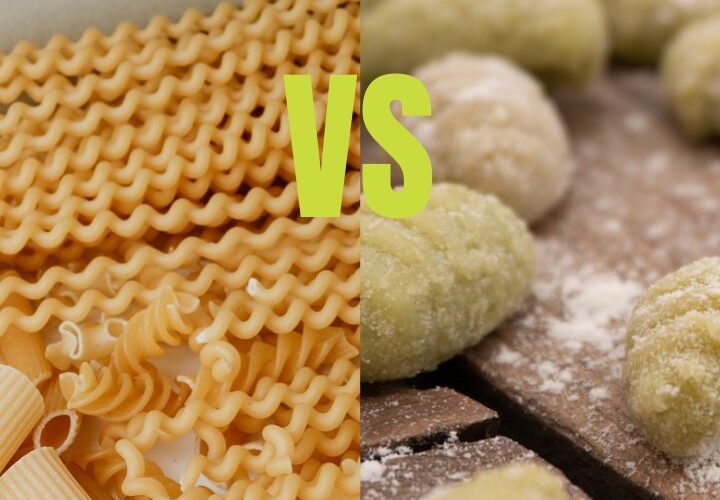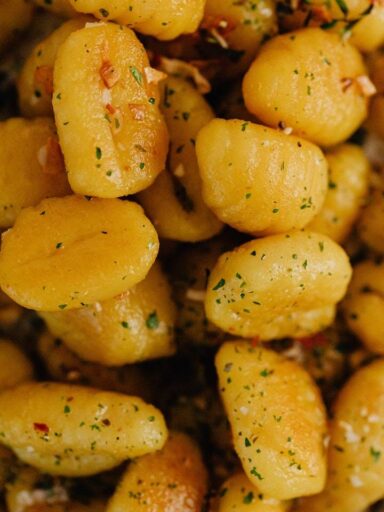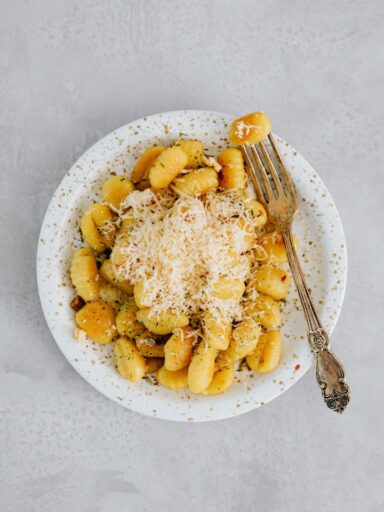Gnocchi vs Pasta: Discover this culinary battle as we delve into their origins, differences, flavors, costs, and more. A tasty showdown awaits!
What is gnocchi?
Gnocchi, a beloved Italian dish, is a type of pasta that stands out for its unique texture and shape. The word “gnocchi” itself is derived from the Italian word “nocchio,” meaning a knot in wood or gnarl.
It is believed that gnocchi has been enjoyed since ancient Roman times, reflecting its enduring popularity over centuries. Traditionally, gnocchi are small dumplings made from a mixture of boiled potatoes, flour, and sometimes eggs.
The process of making gnocchi involves cooking the potatoes until they are tender and then peeling and mashing them into a smooth consistency. The mashed potatoes are then combined with flour to form a dough that is rolled into long ropes before being cut into bite-sized pieces.
These pieces are often pressed against the back of a fork to create textured grooves that help the sauce cling to them. The beauty of gnocchi lies in its delicate yet substantial texture.
When cooked properly, it should be light and pillowy on the inside while slightly chewy on the outside. This gives it an appealing mouthfeel that sets it apart from traditional pasta varieties such as spaghetti or penne.
Gnocchi’s softer texture allows it to absorb sauces more effectively, resulting in bursts of flavor with each bite. Gnocchi can serve as an excellent canvas for various flavors and ingredients, making it incredibly versatile in culinary applications.
From classic combinations like tomato sauce or pesto to more adventurous pairings like broccoli cheddar or salmon cream sauce, there are endless possibilities when it comes to enjoying this delightful pasta alternative. Gnocchi is a delectable Italian creation made from mashed potatoes and flour dough.
Its unique texture distinguishes it from regular pasta varieties while also lending itself well to various sauces and accompaniments. Whether you choose to make your own homemade gnocchi or enjoy store-bought options, this culinary delight guarantees a memorable dining experience.
How to make gnocchi?
Gnocchi, the delightful Italian dumplings, offer a delectable alternative to traditional pasta. Making gnocchi from scratch may seem daunting at first, but with the right technique and a little practice, you can create pillowy morsels of goodness in your own kitchen. To start, gather your ingredients: potatoes, all-purpose flour, egg yolks, and salt.
Begin by boiling the potatoes until they are tender. Once cooked, drain and allow them to cool slightly before peeling off the skin.
Mash the potatoes using a potato ricer or a fork until no lumps remain. It is crucial to achieve a smooth consistency to ensure light and fluffy gnocchi.
Next, create a well with the mashed potatoes on a clean work surface or in a large mixing bowl. Add flour gradually into the well along with egg yolks and salt.
Gently mix these ingredients together until they form a soft dough. Be cautious not to overmix as it can result in tough gnocchi.
Divide the dough into smaller portions and roll each portion into long ropes about 1 inch thick. Using a knife or bench scraper dusted with flour cut these ropes into bite-sized pieces – typically around 1 inch long – shaping them into small ovals or ridged shapes if desired.
These grooves will help the sauce adhere better to the gnocchi. To cook your homemade gnocchi properly, bring a large pot of salted water to boil over high heat.
Carefully drop in small batches of gnocchi and let them cook until they float to the surface; this usually takes about 2-3 minutes. Using a slotted spoon or spider strainer, remove cooked gnocchi from boiling water and transfer them to your chosen sauce.
With this basic technique mastered, you can explore endless variations of homemade gnocchi recipes such as squash gnocchi served with brown butter sage sauce, tomato soup with gnocchi, salmon gnocchi with creamy dill sauce, or even leftover mashed potato gnocchi. The possibilities are vast, allowing you to personalize your gnocchi creations to suit your taste and preferences.
What is the difference between gnocchi and pasta?
When discussing the difference between gnocchi and pasta, it is important to recognize that they belong to two distinct culinary traditions. Gnocchi, originating from Italy, are small dumplings typically made from potatoes, flour, and eggs. On the other hand, pasta is a staple in Italian cuisine and is made by combining flour with liquid (usually water or eggs) to form a dough that is then shaped into various forms like spaghetti, penne, or lasagna sheets.
One fundamental distinction lies in their ingredients. While pasta primarily consists of flour and liquid, gnocchi incorporates mashed potatoes into the dough mixture.
This addition gives gnocchi a unique texture and flavor profile that sets it apart from traditional pasta dishes. The use of potatoes grants gnocchi a softer, pillowy texture while providing a subtle earthy taste that harmonizes well with a variety of sauces.
Texture also plays a significant role in distinguishing gnocchi from pasta. Gnocchi’s distinctive softness allows it to absorb flavors more readily than pasta does.
This characteristic makes it an ideal companion for rich and hearty sauces such as tomato-based ragù or creamy cheese sauces like broccoli cheddar gnocchi soup or pumpkin gnocchi soup. On the other hand, pasta possesses a firmer bite due to its gluten structure when cooked al dente.
Its texture serves as an excellent vehicle for both light sauces such as tomato basil sauce and delicate olive oil-based dressings. Furthermore, cooking times differ between these two culinary delights.
Pasta typically requires less time to cook compared to homemade potato-based gnocchi because its simple dough composition cooks quickly in boiling water. The thickness of certain types of pasta may affect cooking time slightly but generally remains within the range of 8-12 minutes for al dente perfection.
Conversely, because of their denser composition and potato content, homemade potato gnocchi demands more patience during preparation as they require being boiled until they float to the surface. This process can take anywhere from 2-5 minutes, depending on the size and consistency of the gnocchi.
While both gnocchi and pasta have Italian origins and are beloved components of numerous delectable dishes, they exhibit notable differences in terms of ingredients, texture, and cooking times. Gnocchi’s potato-based dough provides a unique taste and softness that pairs well with robust sauces, while pasta offers a firmer bite that is better suited for lighter sauces.
The cooking time for gnocchi tends to be longer than that of pasta due to its denser composition. Understanding these distinctions allows culinary enthusiasts to appreciate the diverse merits each brings to the table when it comes to creating gastronomic masterpieces.
what are the types of gnocchi?
When it comes to exploring the world of gnocchi, one quickly realizes the vast array of types and variations that exist. From traditional potato gnocchi to innovative alternatives such as squash or pumpkin gnocchi, there is no shortage of options to tantalize the taste buds.
The classic potato gnocchi reigns supreme as the most well-known and beloved variation. Made with a combination of boiled potatoes, flour, and often eggs, these soft and pillowy dumplings are a true Italian delicacy.
The process involves painstakingly working the dough until it reaches the perfect consistency – light, yet sturdy enough to hold its shape when cooked. Potato gnocchi can be enjoyed with various sauces such as tomato-based ones like Tomato Soup With Gnocchi or even paired with rich flavors like Salmon Gnocchi.
Another popular type is ricotta gnocchi. These delicate creations are crafted using ricotta cheese instead of potatoes.
The addition of this creamy cheese gives the dumplings a luscious texture and a subtle tanginess that pairs beautifully with savory sauces like broccoli cheddar or chicken gnocchi soup instant pot. For those looking for healthier alternatives, whole wheat gnocchi offers a nutritious twist on this Italian staple.
Made with whole wheat flour instead of all-purpose flour, this version retains all the flavors and textures while providing added fiber and nutrients. Whole wheat gnocchi can serve as an excellent base for dishes like Cavatelli vs Gnocchi where the hearty sauce complements its robust flavor.
In recent years, chefs have also embraced inventive twists on traditional recipes by incorporating various vegetables into their creations. Squash gnocchi has gained popularity due to its vibrant color and unique flavor profile.
Whether it’s butternut squash or pumpkin puree that lends its essence to these dumplings, they add an earthy sweetness that pairs harmoniously with both creamy and tangy sauces alike – think Pumpkin Gnocchi Soup or a savory sage butter sauce. Ultimately, the world of gnocchi is a playground for culinary creativity.
From classic potato gnocchi to innovative vegetable-based variations, there are endless possibilities to explore and savor. Whether you prefer the traditional or are open to culinary adventures, there is a type of gnocchi out there that will delight your taste buds and leave you craving for more.
what are the types of pasta?
When it comes to pasta, there is an incredible variety of shapes and types that can satisfy any palate. From the classic spaghetti and macaroni to more intricate and lesser-known varieties, pasta offers a world of culinary possibilities. One popular type is cavatelli, which hails from Southern Italy.
This small shell-shaped pasta is often made by rolling small pieces of dough against a ridged surface, resulting in a delightful texture that holds the sauce well. Cavatelli pairs perfectly with hearty meat sauces or simple tomato-based ones.
Another delectable type of pasta is farfalle, also known as bow-tie pasta due to its distinctive shape. This versatile option adds a touch of elegance to any dish with its butterfly-like appearance.
Farfalle works wonderfully in both creamy sauces and lighter dressings, making it a favorite for pasta salads or dishes with seafood such as salmon gnocchi salad. Speaking of seafood, linguine is an excellent choice when it comes to pairing with delicate fish or shellfish.
Its long, flat shape complements the flavors and textures of dishes like linguine alle vongole (linguine with clams). For those seeking healthier alternatives without sacrificing taste, whole wheat gnocchi provides a nutritious option that still satisfies cravings for tender dumplings.
Made from whole grain flour rather than refined white flour like traditional gnocchi, this type offers higher fiber content while maintaining the beloved soft texture we cherish in these Italian treats. Whole wheat gnocchi can be served with various sauces such as tomato-based ones or tossed with sautéed vegetables for a wholesome vegetarian meal.
The world of pasta extends beyond these examples to include countless other varieties like fusilli, rigatoni, penne, and orecchiette – each distinct in shape and texture designed to enhance different culinary creations. Whether you are preparing an exquisite pumpkin gnocchi soup or simply enjoying leftover mashed potato gnocchi, the diversity of pasta options allows for endless creativity and exploration in the kitchen.
which one is better to lose weight?
When it comes to weight loss, choosing the right foods is crucial. Both gnocchi and pasta are carbohydrate-based foods, but they differ in their nutritional profiles and potential impact on weight management. Understanding these differences can help individuals make informed decisions about which option may be better for their weight loss goals.
Gnocchi is traditionally made from potatoes, flour, and sometimes eggs, resulting in a dense and chewy texture. While it can be a delicious comfort food, it tends to have higher calorie content compared to pasta due to the addition of starchy potatoes.
However, there are variations such as whole wheat gnocchi or using alternative ingredients like cauliflower or broccoli that offer lower-calorie options. On the other hand, pasta is typically made from durum wheat semolina or other grains.
It comes in various shapes and sizes such as spaghetti, penne, or fusilli. When consumed in moderation and paired with nutrient-rich sauces and toppings like vegetables or lean proteins, pasta can be a part of a balanced diet for weight loss.
Opting for whole grain or whole wheat versions of pasta offers additional benefits such as higher fiber content which aids in digestion and helps promote feelings of fullness. It’s important to note that portion control plays a significant role in weight management regardless of whether you choose gnocchi or pasta.
While both options can fit into a healthy eating plan when consumed mindfully and in appropriate portions, it’s essential to consider the overall calorie intake from other ingredients used with them. Balancing your meal with vegetables rich in fiber along with lean proteins will contribute to maintaining satiety while controlling caloric intake.
When considering which option may be better for weight loss between gnocchi and pasta, it’s important to take into account factors such as ingredient choices (potatoes vs. flour), portion sizes consumed at each mealtime, cooking methods (baked vs fried), accompaniments (sauces and toppings), and individual dietary preferences.
Incorporating whole wheat or grain options, along with a variety of vegetables, can be beneficial for both taste and achieving weight loss goals. Ultimately, choosing the option that aligns with your personal preferences and dietary needs, while practicing portion control, will contribute to a successful weight loss journey.
pasta vs gnocchi, which one is more expensive?
When it comes to comparing the cost of pasta and gnocchi, several factors need to be considered. The price of these two culinary delights can vary depending on various factors such as ingredients, preparation methods, and market demand.
Generally, pasta tends to be more affordable than gnocchi due to its simple composition and widespread popularity. Pasta is made from basic ingredients such as flour, water, and sometimes eggs.
These ingredients are inexpensive and widely available in most grocery stores. Additionally, the production process for pasta is streamlined and efficient, making it a cost-effective option for both consumers and producers.
Whether you opt for classic spaghetti or fancier varieties like fettuccine or penne, pasta remains an affordable choice that can easily suit any budget. On the other hand, gnocchi tends to be slightly pricier due to its specific ingredients and labor-intensive preparation process.
Traditional gnocchi is made using boiled potatoes mixed with flour or semolina. While potatoes are relatively inexpensive, their transformation into pillowy dough requires time-consuming steps like boiling, peeling, mashing or ricing before incorporating them with flour.
This extra effort contributes to the higher cost of gnocchi compared to pasta. Moreover, certain gourmet variations of gnocchi can further increase its price point.
Unique flavors like pumpkin gnocchi or squash gnocchi often involve specialized ingredients that may not be as readily available or require additional processing techniques. These exclusive options tend to come with a higher price tag but offer a distinct culinary experience worth considering for those willing to splurge on their meals.
While pasta generally comes at a more wallet-friendly price point due to its simpler composition and production process, the cost comparison between pasta and gnocchi depends on various factors such as specific types of both dishes and any added gourmet elements involved in making them. Ultimately though, both options offer delicious possibilities that can suit different tastes and budgets alike.
Pasta vs gnocchi, which one takes more time to make?
When it comes to comparing the time required to make pasta and gnocchi, there are several factors to consider. The preparation process for both dishes differs significantly, which ultimately affects the time investment.
Gnocchi, being a potato-based dish, involves a more intricate and time-consuming preparation compared to pasta. To create the perfect texture and consistency of gnocchi, one must first boil or bake potatoes until they are cooked through and then carefully mash them.
This delicate procedure ensures that no lumps remain in the potato mixture, guaranteeing light and fluffy gnocchi. After mashing the potatoes, flour is incorporated gradually until a dough is formed.
This dough is then shaped into small individual pieces by hand or using a fork to create ridges on each gnocchi. The process of shaping each piece can be meticulous and time-consuming, especially for those new to making gnocchi.
Additionally, because gnocchi requires additional steps such as boiling or baking before serving, this adds extra minutes to its overall preparation time. On the other hand, making pasta tends to be relatively quick compared to preparing gnocchi.
Pasta dough typically consists of simple ingredients such as flour and eggs mixed together until a smooth dough is obtained. Once the pasta dough has been kneaded adequately, it needs to rest for some time before rolling it out into thin sheets using a rolling pin or a pasta machine.
Unlike with gnocchi where each piece needs individual shaping attention, pasta can be cut into various shapes – linguine, spaghetti, penne – quickly using specialized tools or even done by hand. While both pasta and gnocchi require some level of effort in their preparation process, it is safe to say that making homemade gnocchi demands more time due to the intricate steps involved in achieving the desired texture and shape of each piece.
However, despite taking longer than pasta in terms of preparation time investment., this shouldn’t discourage you from trying your hand at making gnocchi. The end result of savoring a plate of delicate, pillowy gnocchi is worth every minute spent in the kitchen.
Conclusion
The debate between gnocchi and pasta boils down to personal preference and specific culinary needs. Both gnocchi and pasta have their own unique qualities that make them beloved in their respective ways. Gnocchi, with its soft and pillowy texture, offers a delightful melt-in-your-mouth experience that is unmatched by pasta.
The versatility of gnocchi allows it to be paired with a variety of sauces and ingredients, such as in dishes like Cavatelli vs Gnocchi or Pumpkin Gnocchi Soup. On the other hand, pasta has been a staple in many cuisines for centuries and comes in countless shapes and sizes.
From classic spaghetti to elaborate lasagna, there is a pasta dish for every occasion. Pasta has the advantage of being relatively quick to cook, making it an ideal choice for those who are short on time but still want a satisfying meal.
Salmon Gnocchi or Chicken Gnocchi Soup Instant Pot are examples where gnocchi can be combined with other ingredients creating exceptional flavors. When it comes to health considerations, whole wheat versions of both gnocchi and pasta are available as alternatives that offer added nutritional benefits.
However, it’s important to note that portion control is key when enjoying these carbohydrate-rich dishes if you’re aiming to lose weight. While both gnocchi and pasta can be part of a balanced diet when consumed in moderation, it’s always wise to consult with a healthcare professional or registered dietitian for personalized advice.
Whether you prefer the delicate texture of gnocchi or the wide array of shapes offered by pasta, both have their place in the culinary world. The decision ultimately rests on your taste preferences and specific dietary needs.
So go ahead, experiment with Tomato Soup With Gnocchi or Leftover Mashed Potato Gnocchi, or indulge yourself in Broccoli Cheddar Gnocchi Soup or Squash Gnocchi – whichever path you choose will surely lead to a delightful culinary experience. Embrace the beauty of these beloved Italian staples and savor every bite with joy and appreciation for the diversity of flavors that both gnocchi and pasta bring to our plates.
If you liked the comparison of Gnocchi vs Pasta, let me know in the comments below.




